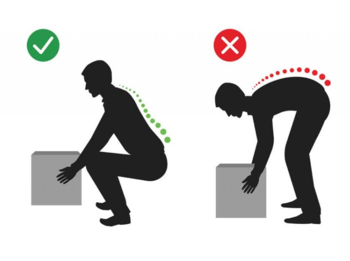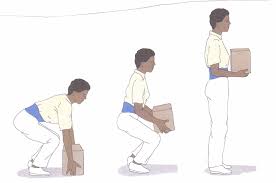Lifting
Original Editor - The Open Physio project
Top Contributors - Oladayo Babalola, Admin, Rachael Lowe, Lucinda hampton, Kim Jackson, Niha Mulla and WikiSysop
Introduction[edit | edit source]
Many lower back injuries come about as a result of poor lifting techniques, something that physiotherapists are uniquely placed to address.
- Lifting heavy items is one of the leading causes of injury in the workplace.
- Bending, followed by twisting and turning, were the more commonly cited movements that caused back injuries.
- Strains and sprains from lifting loads improperly or from carrying loads that are either too large or too heavy are common hazards associated with manually moving materials.
- When using smart lifting practices, people are less likely to suffer from back sprains, muscle pulls, wrist injuries, elbow injuries, spinal injuries, and other injuries caused by lifting heavy objects[1].
The following principles of safe lifting should be covered whenever you treat a patient with Lower back pain.
Principles of Safe Lifting[edit | edit source]
- Assess the immediate area and load to be lifted.
- Bend the knees to lower the body to the level of the load.
- Keep feet shoulder width apart to ensure a broad, stable base.
- Keep the back straight (though not necessarily erect).
- Use a firm, palmar grip.
- Keep the arms close to trunk.
- Keep the load / weight close to the Centre of gravity and within the Base of support.
- Point / pivot the feet in the direction of the movement. Never rotate the trunk while lifting.
- Lift using the strong muscles in the legs, rather than the postural muscles in the trunk.
- If the load is too heavy for one person, wait until you can get help.
Important Things To Remember[edit | edit source]
- Use mechanical means (e.g. hand trucks, pushcarts, etc.) when possible for heavier or awkward loads.
- Easier and safer to push than to pull.
- Keep loads as close to the body as possible and do not twist while lifting, carrying, or setting down a load. Nose, shoulders, hips, and toes should all be facing the same direction.
- Minimize reaching.
- Stoop or squat if the load is below you and a ladder if it is too high.
- As a general rule, bend at the knees, not the hips.
- Get help when needed.
- Plan ahead for all parts of the lift: lifting, carrying, and setting down.
- Try to utilize proper handholds while lifting. If an item does not have a good handhold, think of ways to remedy this, such as placing the item in a container with good handholds, creating a safe and proper handhold with an appropriate tool, etc.
- Use personal protective equipment where needed, such as gloves with good grip and steel-toed boots where appropriate.
- Clear pathway before carrying, lifting, pushing or pulling.
- Implement rest breaks and job rotation for frequent and/or heavy lifting.
- Place items to be lifted within the “power zone”. ie close to the body, between the mid-thigh and mid-chest of the person doing the lifting. This is the area where the arms and back can lift the most with the least amount of effort.
Lifting Techniques[edit | edit source]
Basic Lift (Diagonal Lift)[2]
This is the most common lifting technique. Used for loads small enough to straddle.
- Stand with a wide stance and put one forward to the side of the load.
- Lower yourself down to the object with your hips and knees while keeping your back straight.
- Keep upper limbs parallel to each other.
- Keep trunk in vertical lumber neutral position.
- Grasp firmly the handles of the load (if it has handles) or on opposite corners.
- Lift by extending your knees with your back straight.
Power Lift
This is similar to the basic lift. It is used for loads too large to straddle.
- Put out one foot to the side of the object.
- Lower yourself into the knee behind.
- Keep trunk in vertical lumber neutral position.
- Maintain anterior pelvic tilt.
- Lift by extending your knees with your back straight, and breath out as you lift.
Tripod Lift
This is used for loads with uneven weight distribution such as bag of grains etc.
- Put out one foot to the side of the object.
- Lower yourself into the knee behind.
- Lift the load onto the thigh beside the object.
- Position both forearms under the load and hug to your chest.
- Keep trunk in vertical lumber neutral position.
- Maintain anterior pelvic tilt.
- Lift by extending your knees with your back straight..
Strait Leg Lift
This technique is used when an obstacle is preventing the lifter from bending the knees e.g lifting out of a car trunk.
- Knees are slightly flexed (if the obstacle is stable, you can lean on it for support).
- Keep trunk in vertical lumber neutral position.
- Lift by extending your knees with your back straight.
One-Leg Stance (Golfers lift)
This technique is used to pick small light objects.
- Rest hand on the edge of a nearby object/fixed surface.
- Keep trunk straight and raise one leg straight behind as you lean over to pick the object.
References[edit | edit source]
- ↑ UNC Lifting and handling material Available from:https://ehs.unc.edu/workplace-safety/ergonomics/lifting/ (last accessed 13.9.2020)
- ↑ George Eischen. SportsCare Tips: Proper Lifting Techniques to Prevent Injury. Available from: https://www.sportscarept.com/proper-lifting-techniques/ (accessed 15 April 2022).
- ↑ Dr Walter Salubro. Part 1 Safe Lifting Technique -The Basic Lift | Safe Lifting of Heavy Objects. Available from: https://www.youtube.com/watch?v=VBjK_hGTYtE [last accessed 15/4/2022]
- ↑ Dr Walter Salubro. Part 2 How To Lift Safely With The Power Lift Technique. Available from: https://www.youtube.com/watch?v=yiSn8TAfZvc [last accessed 15/4/2022]
- ↑ Dr Walter Salubro. Part 3 Golfers Lift | How To Lift Safely Light Objects. Available from: https://www.youtube.com/watch?v=IKGZZ35x2nE [last accessed 15/4/2022]
- ↑ Dr Walter Salubro. Part 4 How Do A Tripod Lift | Tripod Lifting Technique. Available from: https://www.youtube.com/watch?v=6PdVV28rgy8 [last accessed 15/4/2022]









